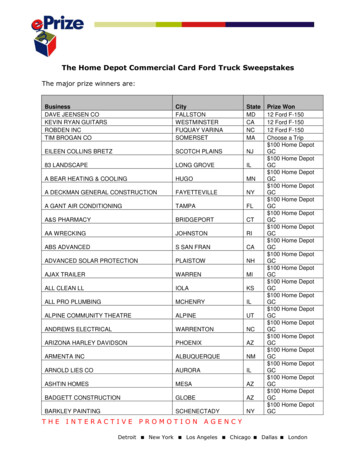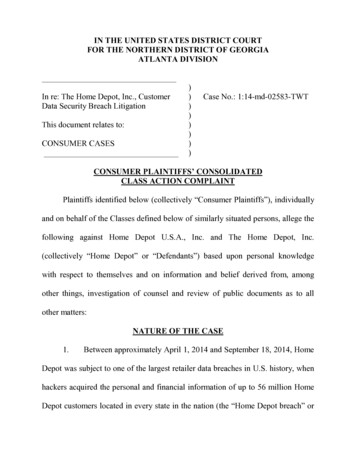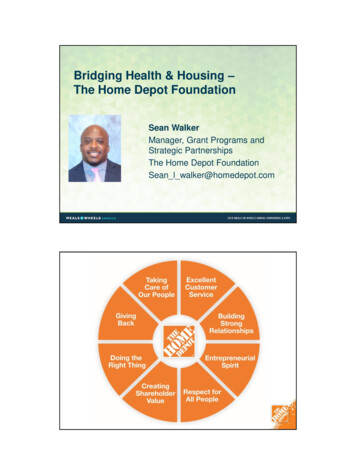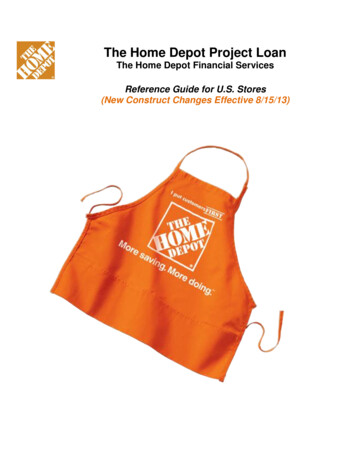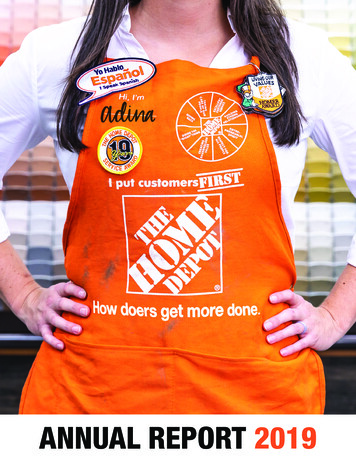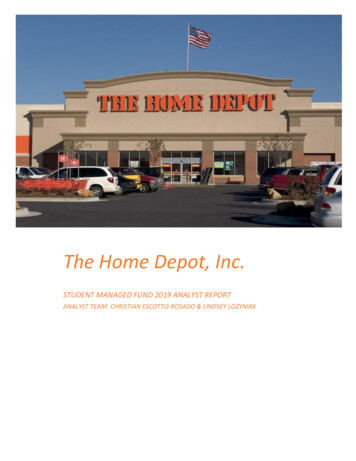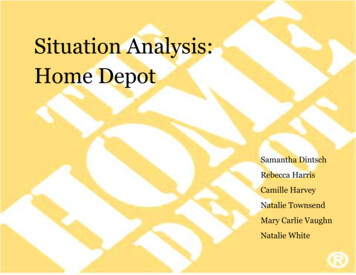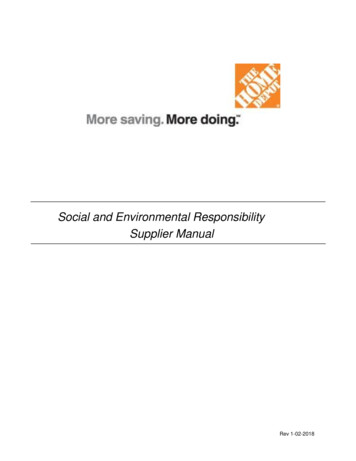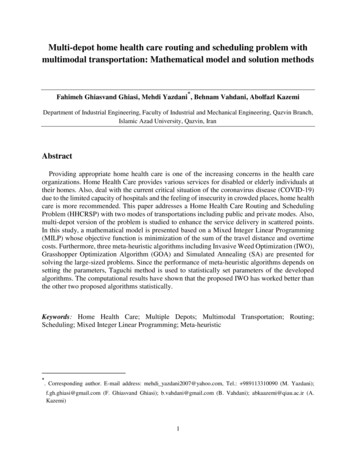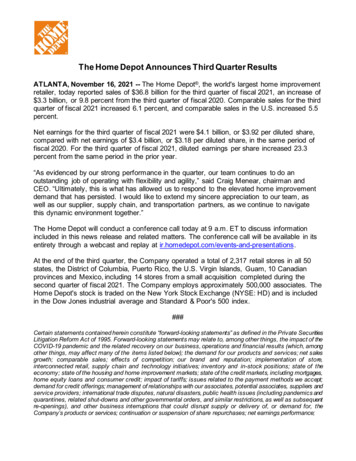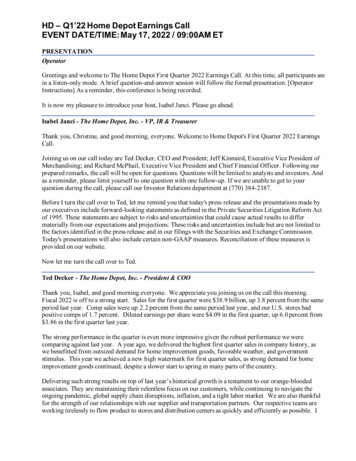
Transcription
HD – Q1’22 Home Depot Earnings CallEVENT DATE/TIME: May 17, 2022 / 09:00AM ETPRESENTATIONOperatorGreetings and welcome to The Home Depot First Quarter 2022 Earnings Call. At this time, all participants arein a listen-only mode. A brief question-and-answer session will follow the formal presentation. [OperatorInstructions] As a reminder, this conference is being recorded.It is now my pleasure to introduce your host, Isabel Janci. Please go ahead.Isabel Janci - The Home Depot, Inc. - VP, IR & TreasurerThank you, Christine, and good morning, everyone. Welcome to Home Depot's First Quarter 2022 EarningsCall.Joining us on our call today are Ted Decker, CEO and President; Jeff Kinnaird, Executive Vice President ofMerchandising; and Richard McPhail, Executive Vice President and Chief Financial Officer. Following ourprepared remarks, the call will be open for questions. Questions will be limited to analysts and investors. Andas a reminder, please limit yourself to one question with one follow-up. If we are unable to get to yourquestion during the call, please call our Investor Relations department at (770) 384-2387.Before I turn the call over to Ted, let me remind you that today's press release and the presentations made byour executives include forward-looking statements as defined in the Private Securities Litigation Reform Actof 1995. These statements are subject to risks and uncertainties that could cause actual results to differmaterially from our expectations and projections. These risks and uncertainties include but are not limited tothe factors identified in the press release and in our filings with the Securities and Exchange Commission.Today's presentations will also include certain non-GAAP measures. Reconciliation of these measures isprovided on our website.Now let me turn the call over to Ted.Ted Decker - The Home Depot, Inc. - President & COOThank you, Isabel, and good morning everyone. We appreciate you joining us on the call this morning.Fiscal 2022 is off to a strong start. Sales for the first quarter were 38.9 billion, up 3.8 percent from the sameperiod last year. Comp sales were up 2.2 percent from the same period last year, and our U.S. stores hadpositive comps of 1.7 percent. Diluted earnings per share were 4.09 in the first quarter, up 6.0 percent from 3.86 in the first quarter last year.The strong performance in the quarter is even more impressive given the robust performance we werecomparing against last year. A year ago, we delivered the highest first quarter sales in company history, aswe benefitted from outsized demand for home improvement goods, favorable weather, and governmentstimulus. This year we achieved a new high watermark for first quarter sales, as strong demand for homeimprovement goods continued, despite a slower start to spring in many parts of the country.Delivering such strong results on top of last year’s historical growth is a testament to our orange-bloodedassociates. They are maintaining their relentless focus on our customers, while continuing to navigate theongoing pandemic, global supply chain disruptions, inflation, and a tight labor market. We are also thankfulfor the strength of our relationships with our supplier and transportation partners. Our respective teams areworking tirelessly to flow product to stores and distribution centers as quickly and efficiently as possible. I
would like to thank them for their ongoing support as we continue to navigate a challenging and dynamicenvironment.The demand seen in the first quarter exceeded our expectations. The home improvement consumer remainsengaged. Customers continue to tell us that their homes have never been more important, and projectbacklogs are very healthy. We believe that the medium-to-longer term underpinnings of demand for homeimprovement have never been stronger.We are thrilled with our Pro performance in the quarter, driven by underlying strength in project demand. Wecontinue to invest in an ecosystem of capabilities including enhanced fulfillment options, a more personalizedonline experience, as well as other business management tools to drive deeper engagement with our Procustomers and we believe our efforts are resonating.We are navigating a unique environment, but we believe we have the tools, the team, and the experience toeffectively manage through. While we don’t know how inflation might impact consumer behavior goingforward, we are closely monitoring elasticities and customer trends across our respective categories andgeographies and remain encouraged by the underlying strength we see in the business. Jeff will provide a bitmore color about what we’ve observed from a category and big-ticket standpoint in a moment.And while inflation impacted our average ticket increase this quarter, it wasn’t the only impact. As we’veseen for the past several years, our customers continue to trade up for premium, innovative products. InMarch, we held an in-person store manager meeting for the first time in three years. One of the manyhighlights of that week is our product walk, where our vendors showcase the latest in product innovation.And what I can share with you is that the level of innovation across the business is robust. In fact, almost 90percent of the products on display this year are entirely new SKUs to The Home Depot, so the pipeline forinnovative products remains very strong.Beyond product and innovation, my biggest takeaway from the store manager’s meeting is how energized theteam is. The exceptional execution our associates delivered over the last few years hasn’t been easy, but ourteams have consistently risen to the challenge. We frequently survey our associate base and are pleased thatengagement and morale remain high.Last quarter we talked about our customer-back approach to remove friction at every touchpoint of theshopping experience. To that end, we recently announced that Matt Carey has been named executive vicepresident of customer experience. In this newly formed role, Matt will partner across the business to helpdesign and develop new and innovative solutions to drive a seamless experience for our customers. As Matttransitions to this new role, we also announced that Fahim Siddiqui has been promoted to executive vicepresident and chief information officer, where he is responsible for all aspects of our technology developmentand strategy. These moves will help drive further alignment around our interconnected retail strategy, whichwill allow us to enhance what we believe is the best customer experience in home improvement.Richard will talk to you in a few minutes about our guidance for the remainder of the year, but the firstquarter certainly got us off to a great start. We’re also encouraged by the continued strength we see in thebusiness through the first two weeks of the second quarter, as spring is breaking more broadly across the U.S.Our team continues to focus on what is most important: our associates and customers. Our merchants, storeand MET teams, supplier partners, and supply chain teams did an outstanding job delivering value and serviceto our customers throughout the quarter. I’d like to close by thanking them for their dedication and hardwork.With that, let me turn the call over to Jeff.
Jeff Kinnaird - The Home Depot, Inc. - EVP, MerchandisingThank you Ted and good morning everyone.I want to start by also thanking all of our associates and supplier partners for their ongoing commitment toserving our customers and communities. As you heard from Ted, during the first quarter, we continued to seeoutsized demand for home improvement projects, and strong execution from our teams and supplier partners.Turning to our comp performance during the first quarter 11 of our 14 merchandising departments postedpositive comps, led by Plumbing, Building Materials, Millwork, and Paint. During the first quarter of thisyear, we saw double-digit negative comps in our seasonal departments due to the late arrival of spring.Appliances posted slightly negative comps. Adjusting for a shift in event timing, appliance comps wouldhave been positive for the quarter. Excluding seasonal categories, we are thrilled with the broad-basedstrength across the business and healthy project demand.During the first quarter, our comp average ticket increased 11.2 percent, and comp transactions decreased 8.4percent. The growth in our comp average ticket was driven primarily by inflation across several productcategories as well as demand for new and innovative products. Comp transactions reflected the late start tospring and the anniversarying of stimulus. And on a two and three-year basis, both comp average ticket andcomp transactions were healthy and positive.Inflation from core commodity categories positively impacted our average ticket growth by approximately240 basis points during the first quarter, driven by inflation in lumber, copper, and building materials.Lumber prices remained volatile during the quarter. As an example, framing lumber peaked at approximately 1,300 per thousand board feet during the first quarter before falling over 400 to approximately 900.Big-ticket comp transactions, or those over 1,000, were up 12.4 percent compared to the first quarter of lastyear. We saw big-ticket strength across many Pro heavy categories like pipe and fittings, gypsum, andfasteners.During the first quarter, Pro sales growth outpaced DIY. On a three-year comp basis, growth with both ourPro and DIY customers was consistent and strong.We’re encouraged by the momentum we are seeing with our Pros and they tell us that their backlogs arestrong. And during the quarter, we saw many of our customers turn to Pros to help them with larger,renovation projects. This can be seen in the double-digit comp performance of our building materials andplumbing departments, as well as in certain kitchen and bath categories like in-stock kitchens, tubs &showers, and countertops. We also saw double-digit growth in our kitchen and bath installation business.This underscores the strength of project demand we are seeing across the business.Sales leveraging our digital platforms increased 3.7% during the first quarter. We are very pleased with theperformance of our digital assets as we delivered the highest sales-dollar volume in company history. Forthose customers that chose to transact with us online during the first quarter, more than 50 percent of ouronline orders were fulfilled through our stores, a testament to the power of our interconnected retail strategy.As you heard from Ted, we are very excited about the innovation we are introducing across the business. Wecontinue to lean into products that simplify the project, saving our customers time and helping them take onmore jobs.One example is our Viega ProPress line in Plumbing. Here, plumbers can create a watertight copperconnection in 60% less time than a traditional copper solder job. Viega ProPress fittings require no flame and
work in wet applications. Viega is the market leader in this space and is exclusive to The Home Depot in thebig-box channel.In paint, working with Masco and PPG, we have put together a formidable pro paint lineup that is resonatingwith our pro painters. Masco’s Behr formulated pro-specific offering continues to perform well in our storesand in the first quarter, we added PPG’s SPEEDHIDE series. This is a Pro-specific paint that is spec’d in avast majority of multi-housing and large commercial projects, giving us an entry point with our pro paintersfor large scale projects. And this is now exclusive to Home Depot in the big-box channel.In spray paint, we launched PPG’s Glidden Max-Flex spray paint. PPG’s proprietary industrial-basedtechnology is uniquely flexible, covering and preserving the original look and feel of a wide range of surfacesincluding leather and fabric.And with Masco, we have expanded their exclusive offerings to spray paints, caulks and sealants, as well asinterior stains.Now let’s turn our attention to Spring and the exciting line-up of products we have for our customers. We arethrilled to showcase our new product offerings across our seasonal categories. We are seeing an industry-wideshift from gas powered to battery-powered mowers. Demand for cordless mowers has never been stronger andour line-up of battery-powered mowers including Ryobi’s 80 volt zero turn riding mower, Milwaukee’s newM18 FUEL walk mower, DeWalt’s FlexVolt walk mower, and Makita’s LXT walk mower is unmatched.This line-up offers something for everyone, building on an ecosystem of innovative tools powered by thesame battery platforms.In patio, we have continued to add optionality and today customers can create their perfect patio set totransform their outdoor living space through an enhanced online experience.And we expanded our assortment of grills. We are particularly excited about our new Traeger Timberline XLwhich provides a larger cooking surface, easier maintenance, and a side burner to enhance your cookingneeds. And our new Neevo Nex-Fi Grill, is the first propane powered grill controlled via an app on yourmobile device. The app displays timers, grill temperatures and internal food temperatures providing aconsistent cooking experience for hours.We are also excited about our Live Goods program. Each year our merchants provide our customers withnew and improved varieties to enhance the overall garden experience. We have expanded our disease anddrought resistant products offering superior performance. For example, Beacon impatiens are diseaseresistant. And our Easy Wave petunias now require less sunlight and last up to six weeks longer. Adding thesenew, hardier plants allows our customers to have vibrant and healthier gardens for longer.Our live goods category looks incredible. We are ready for Spring with everything from shrubs, to a varietyof flower and edibles for every type of gardener.With that, I’d like to turn the call over to Richard.Richard McPhail - The Home Depot, Inc. - EVP & CFOThank you Jeff and good morning everyone.In the first quarter, total sales were 38.9 billion, an increase of 1.4 billion, or 3.8 percent from last year.
During the first quarter, our total company comps were positive 2.2 percent, with positive comps of 12.9percent in February, essentially flat in March, and negative 2.0 percent in April. Comps in the U.S. werepositive 1.7 percent for the quarter, with positive comps of 12.5 percent in February, negative 0.3 percentin March, and negative 2.9 percent in April. Recall that March reflects the anniversarying of stimulus andApril was impacted by a delayed spring this year.Our results this quarter were, once again, driven by continued strength across the business. Springtemperatures broke late in all our geographies but in particular impacted some of our Northern Regions.In local currency, both Mexico and Canada posted comps above the Company average.In the first quarter, our gross margin was 33.8 percent, a decrease of approximately 20 basis points fromlast year, primarily driven by supply chain investments and pressure from lumber. We continued tosuccessfully offset significant transportation and product cost pressures, while maintaining our position asthe customer’s advocate for value.During the first quarter, operating expense as a percent of sales remained essentially flat to last year atapproximately 18.6 percent. We were pleased with our operating expense performance during the firstquarter which reflected planned increases in wage and planned roll-out of investments designed to driveefficiency in our store environment.Our operating margin for the first quarter was 15.2 percent, compared to 15.4 percent in the first quarterof 2021.Interest and other expense for the first quarter increased by 36 million to 369 million, due primarily tohigher long-term debt levels than one-year ago.Our effective tax rate was 23.9 percent in the first quarter of both fiscal 2022 and 2021.Our diluted earnings per share for the first quarter were 4.09, an increase of 6.0% percent compared tothe first quarter of 2021.Our total store count at the end of the quarter was 2,316 and selling square footage was 240 millionsquare feet. Unfortunately, during the quarter, we lost a store in San Jose, California due to a fire.Thankfully, no one was injured, and all of our associates have been re-assigned to other nearby stores andthe team has done a fantastic job continuing to serve our customers in the area.At the end of the quarter, inventories were 25.3 billion, up 6.1 billion compared to the first quarter of2021 and inventory turns were 4.4 times, down from 5.5 times last year. This level of inventory reflectsoutsized demand for home improvement projects, actions taken to improve in-stocks, and the impact ofthe delayed start to spring. While our in-stock position is not back to pre-pandemic levels, it is thehealthiest it has been since the pandemic began.Turning to capital allocation after investing in our business and paying our dividend, it is our intent toreturn excess cash to shareholders in the form of share repurchases.
As we have mentioned on previous calls, we plan to continue investing in our business withcapex of approximately 2 percent of sales on an annual basis. We also plan to maintain flexibilityto move faster or slower, depending on the environment.During the first quarter, we invested approximately 700 million back into our business in theform of capital expenditures.And during the quarter, we paid approximately 2.0 billion in dividends to our shareholders andwe returned approximately 2.25 billion to shareholders in the form of share repurchases.Computed on the average of beginning and ending long-term debt and equity for the trailing twelvemonths, return on invested capital was approximately 45.3 percent, up from 45.1 percent in the firstquarter of fiscal 2021.Now I will comment on our updated guidance for fiscal 2022.As you heard from Ted, we are very pleased with the strong performance we saw during the first quarterwhich surpassed our expectations. Today we are raising guidance for 2022. We now expect sales growth and comp sales growth of approximately 3% for fiscal 2022We expect comps to be stronger in the first half of the year than the second half of the yearWe expect our fiscal 2022 operating margin to be approximately 15.4% for the yearAnd we would expect mid-single-digit percent growth in diluted earnings per share compared tofiscal 2021While a number of uncertainties remain, we feel confident that we will be able to continue to managethrough a dynamic environment while growing faster than our market and delivering exceptionalshareholder value.Thank you for your participation in today’s call, and Christine we are now ready for questions.Q U E S T ION A N D A N S WE ROperator[Operator Instructions] Our first question comes from the line of Michael Lasser with UBS. Please proceedwith your question.Michael Lasser - UBS, AnalystGood morning. Thanks a lot for taking my question. Understanding that your overall results were verystrong; are you seeing any signs that either inflationary pressure, rising interest rates or simply homeimprovement fatigue are starting to have a negative impact on the business? And does it give you pausethat comp transactions were down high single digits in the quarter as maybe a leading indicator that thebusiness could soften from here?
Ted Decker - The Home Depot, Inc. - President & CEOThanks, Michael. Good morning. So a lot in that question. As we said, we had a great Q1 in comp-tocomp from last year. As you recall, Q1 last year was our highest first quarter sales and our highest compat 31% in a very, very long time. So as we went into this year, we were understandably conservative as tohow we thought Q1 would pan out. But in fact, we saw that the consumer is very engaged. The Pro isvery strong and we posted those results with very much delayed spring. In Q2, it's early, but we're off to astrong start. We also think that the fundamentals – these are all very short term in nature comments, butthe fundamentals for home improvement remain incredibly supportive.So when you look at inflation and interest rates and any fatigue, if I take those in order; inflation isdefinitely higher than we thought. If you recall, last year, we thought we'd have about 5% growth inticket. We're seeing obviously much higher than that with 11% in ticket. A lot of that is inflation-driven.But our customers are resilient. We are not seeing the sensitivity to that level of inflation that we wouldhave initially expected. On interest rates, and Richard can talk a little bit more about interest rates inhousing. But we have not seen that impacting our business in the nature of housing, again, Richard willcover in greater detail.And then the fatigue, we're not seeing at all. We'd look at PCE and shifts in PCE. And while we areseeing some shift to services in general, we're not seeing a big shift out of home improvement. And we'renot seeing fatigue with our customers given repairer/remodeler intent and activity still tracking at thehighest levels that we've recorded. And then lastly, on transactions, we do always look for a balance ofticket and transactions. But again, with these inflation rates, it's a very unique year in inflation and ticketis higher than norm for sure. But again, the consumer's hanging in there.And Richard, why don't you touch on the interest rates?Richard McPhail - The Home Depot, Inc. - EVP & CFOSure. So just first to start with who our customer is. You need to keep in mind our customers arehomeowners. Virtually all sales to our Pro customers are on behalf of a homeowner and over 90% of ourDIY customers are homeowners as well. So let's talk about home improvement demand and what drivesit.Over our history, we've seen that home price appreciation is the primary driver of home improvementdemand. When your home appreciates in value, you view it as a smart investment and you spend more onit. So let's look at what's happened to home prices. We've seen appreciation of over 30% over the last twoyears. In fact, home equity values over the last two years have increased by 40% or over 7 billion just inthe last two years.So the homeowner has never had a balance sheet that looks like this. They've seen the price appreciationand they have the means to spend. And in surveys, our customers tell us that their homes have never beenmore important and their intent to do projects of all sizes has never been higher. And our Pros say thesame thing about their backlogs.So let's talk about interest rates. I think it's important to remember that our addressable market is the 130million housing units occupied in the US plus probably, call it, 40 million to 50 million more in Canadaand Mexico. Of those 130 million housing units, on any given year, only about 4% or 5% are sold. Thatmeans that over 95% of our customers are staying in place. They're not shopping for a mortgage. Nearly40% of those homes are owned outright. Of those who have mortgages, about 93% of those mortgages arefixed rate.
So when you think about our addressable market, the vast majority aren't really paying attention tomortgage rates. And what's interesting about that is what we've heard. When they do look at moving,they're actually more and more tempted to stay in their low fixed rate mortgage and remodel their homeinstead. So these low locked-in mortgages are probably a benefit to home improvement.Michael Lasser - UBS, AnalystThat's all very helpful information. And in light of that, I hate to follow up with such a negative question.But out of an abundance of conservatism, I'll ask that historically Home Depot has talked about a 20basis-point margin change for every 1% increase or potentially decrease in its same-store salesrecognizing that the environment hasn't necessarily been business as usual for quite some time.If we do want to take a conservative expectation on the overall macro, would it be reasonable to think thatif comps were to decline 1%, that that would translate to a 20-basis-point decline in operating margin? Orhas the business just advanced so much over the last few years through the deployment of technology, agreater sophistication of supply chain and other factors that perhaps the deleverage wouldn't be assignificant moving forward as it might have been in the past?Richard McPhail - The Home Depot, Inc. - EVP & CFOWell, Michael, first, we operate an activity-based model with respect to payroll, which is our largestoperating cost. And so that naturally decreases as volume decreases. More importantly, we operate with adegree of financial flexibility in our P&L. And that financial flexibility allows us to manage as we think isappropriate in any given environment. So we have room to manage. And we're confident that we can takeshare in any environment and manage this P&L wisely for the environment. With respect to any oldbenchmarks we may have given, we're beyond that. We have financial flexibility in our model. Andagain, we would flex to sort of meet the circumstances as we would see them.Michael Lasser - UBS, AnalystThat's helpful. Thank you so much and good luck.OperatorOur next question comes from the line of Simeon Gutman with Morgan Stanley with UBS. Pleaseproceed with your question.Simeon Gutman - Morgan Stanley, AnalystHey, everyone. My first question is if we could talk a little more detail around the intent and the backlogthat was just mentioned. Curious if you're seeing demand come through because supply was constrained,there are some pent-up projects versus what the backlog or pipeline continues to build.Richard McPhail - The Home Depot, Inc. - EVP & CFOWell, I think you can just start with some survey results. These are public and these are published by theNational Association of Home Builders. This is a survey that goes back to 2001. And the survey, if you'llbear with me, just sort of says are you optimistic or pessimistic, 50 being kind of the median mark here.
So for the 20 years up to 2020, that optimism index never got above a 58. Today, it stands at an 86, sothat is the sentiment of the remodeler. With respect to backlog, that is also surveyed. That number overthe past 20 years never got above a 64. Today, it stands at an 84. Both of those sentiment numbers are atall-time highs.Simeon Gutman - Morgan Stanley, AnalystFair enough. And maybe a follow-up. You mentioned home price appreciation being the most importantlever. It looks like the home prices in Canada are starting to turn a bit and the business seems to beholding up well. Can you talk about if that relationship holds or if the same dynamic, the macroconditions for the customer exists and that's why the business is sort of breaking away from that trend?Ted Decker - The Home Depot, Inc. - President & CEOWell, yeah, our Canadian business – I'm not as up to speed, Simeon, on the Canadian stats that Richardjust went through for the US. But our Canadian business is in terrific shape. Remember they had muchmore significant lockdowns last year, Ontario in particular. Our stores were closed in the first quarter andwe had curbside pickup only. So the business is very, very strong. I don't have as much detail on therelationship with home prices.Richard McPhail - The Home Depot, Inc. - EVP & CFOWell, let's just sort of reflect on something. So last Q1, as a company, we reported a 31% comp. Canadawas higher than that. So we had a tougher comp in Canada. And this quarter, our comp in Canada washigher than the company average.OperatorOur next question comes from the line of Mike Baker with DA Davidson. Please proceed with yourquestion.Mike Baker - DA Davidson, AnalystOkay, two. One, simply can you just quantify, if there's any way to quantify, the weather impact, the latespring? How much did that hurt April? And what should we expect that to contribute into May? And thenI'll have a follow-up question.Ted Decker - The Home Depot, Inc. - President & CEOSo for the quarter, Michael, we think it was about 1%, the negative impact to comp sales in Q1.Mike Baker - DA Davidson, AnalystAnd presumably, most of that occurs in April. Is that fair to say?Ted Decker - The Home Depot, Inc. - President & CEOYeah, because February, it's not spring anywhere and it's our lowest volume month. So yes, that's Aprildriven. As Richard said in his notes, March was more of a stimulus impact as well as a weaker spring in
the south. And then as you started to move toward northern markets, particularly cold weather in April,and for the quarter, 1%.Mike Baker - DA Davidson, AnalystYeah. We've all felt that cold weather up here in the northeast, although it's getting better now. I alsowanted to follow up on the home price appreciation question. We've all looked at this for many years andI think most people get that home price appreciation is that important. How concerned are you that higherinterest rates eventually slow down existing home sales – and we've seen that decline three or four monthsin a row – such that the record home price appreciation that we're seeing eventually has to slow downparticularly as the Fed keeps raising rates? And so how big of a concern is that as you think about the restof the year?Richard McPhail - The Home Depot, Inc. - EVP & CFOWell, I think we're in a unique position now in recent housing history where we have built a chronicshortage of housing units in the US consistently and steadily for the last 10 years. Some economistsassume that that shortage is a little less than 2 million. You hear numbers as high as 4 million. If you takeother estimates of what will likely be built, we're looking at at least five years – if not seven or eight years– before we could actually get back to a point of equilibrium. So we believe that supply and demand aregoing to be the main drivers of support for home price appreciation. And we know that that chronicundersupply is goi
HD - Q1'22 Home Depot Earnings Call EVENT DATE/TIME: May 1 7, 2022 / 09:00AM ET . PRESENTATION . Operator . Greetings and welcome to The Home Depot First Quarter 2022 Earnings Call. At this time, all participants are in a listen -only mode. A brief question- and-answer session will follow the formal presentation. [Operator
